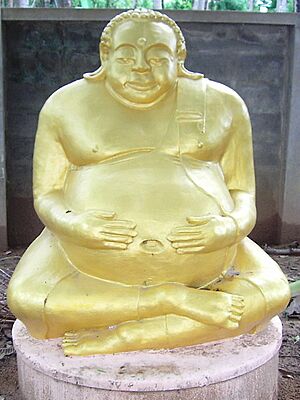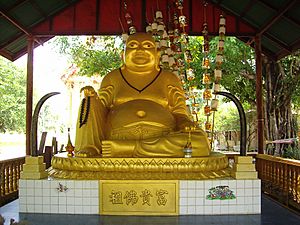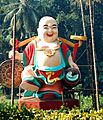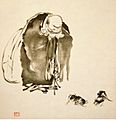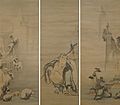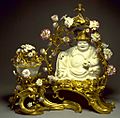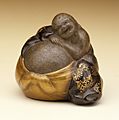Budai facts for kids
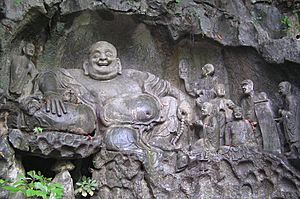
Budai (pronounced Boo-dye in Chinese and Hoh-tay in Japanese) is a famous Buddhist monk from ancient China. Many Chinese Buddhists believe he was a new form of Maitreya, who is believed to be the next Buddha after Gautama Buddha.
You can find pictures and statues of Budai in many temples, restaurants, and shops. He has become a symbol of happiness and good fortune in some types of Buddhism and Taoism. In Japan, Hotei is one of the Seven Lucky Gods. He is almost always shown smiling or laughing, which is why he is often called the "Laughing Buddha" in Chinese.
Contents
Who Was Budai?
An Ancient Monk
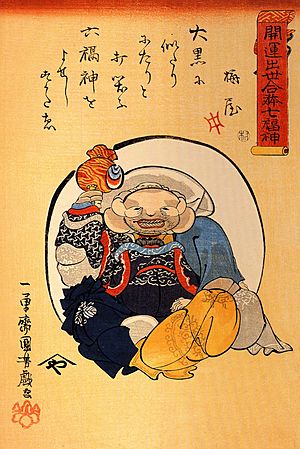
Some stories say Budai might be based on a monk named Angida who lived during the time of Gautama Buddha. Angida was an Indian snake catcher who helped people by catching poisonous snakes. Budai and Angida are often shown in similar ways: they are both plump, laughing, and carry a bag.
A Chinese Monk
In China, Budai was a real monk who lived around 907 to 923 CE. He was known for being kind and loving. People believed he was connected to the Maitreya Bodhisattva (the future Buddha) because of a special poem he said before he died:
- Maitreya, the true Maitreya
- has billions of forms.
- Often he is shown to people;
- other times they do not recognize him.
This poem made people think he was Maitreya himself, appearing in a different form.
What Does Budai Look Like?
Budai is almost always shown carrying a large sack that never seems to empty. This sack is full of many good things, like rice plants (which mean wealth), sweets for children, food, and even the sadness of the world. His job is to protect those who are weak, poor, and children.
In Chinese Buddhist temples, you'll often see a statue of Budai right at the entrance. He is usually a stout, smiling, or laughing man wearing robes. His large, bare belly is a symbol of happiness, good luck, and plenty.
Some statues also show small children playing at his feet. Another item you might see with Budai is a begging bowl, which shows that he is a Buddhist monk. All these images show Budai as a traveling monk who goes around and takes away people's sadness. Because he represents wealth and happiness, his statues are often found in homes and businesses in China and Japan.
Similar Figures
In Thailand, Budai is sometimes confused with another respected monk called Phra Sangkadchai (pronounced Prah Sang-ka-chai). Phra Sangkadchai was a monk who lived during the time of the Buddha. The Buddha praised him for being very good at explaining difficult Buddhist teachings in a simple way.
Even though you might find statues of both Budai and Phra Sangkadchai in temples in Thailand and China, Phra Sangkadchai is more common in Thai temples, and Budai is more common in Chinese temples. Here are two ways to tell them apart:
- Phra Sangkadchai usually has a little hair on his head, while Budai is bald.
- Phra Sangkadchai wears his robes in the Theravada Buddhist style, folded over one shoulder, leaving the other uncovered. Budai wears his robes in the Chinese style, covering both arms but leaving the front part of his upper body bare.
Fun Beliefs About Budai
A popular belief is that if you rub Budai's belly, it will bring you wealth, good luck, and success. This is not a formal Buddhist practice, but it's a fun part of Chinese folk beliefs. People often admire Budai for his happiness, abundance, wisdom, and feeling of contentment.
Related pages
Images for kids
-
Sculpture of Budai at the Feilai Feng grottoes in Zhejiang, China. Northern Song dynasty, 11th century.
-
Glazed ceramic sculpture of Budai. Ming dynasty, 1486.
-
Statue of Budai at Hushan Temple in Taiwan.
-
Statue of Budai as Maitreya at Haedong Yonggungsa temple in South Korea.
-
Statue of Budai at Miroku-ji in Himeji city, Hyōgo Prefecture, Japan. It is the largest Budai sculpture in Japan.
-
Statue of Budai at Vĩnh Tràng Temple in Vietnam.
-
Statue of Budai at Ko Samui island, Thailand.
-
Small statue at a cafe in Birmingham, United Kingdom.
-
Painting of Podae, by Kim Myong-kuk, Joseon dynasty, 1600–1650.
-
Painting of Hotei watching two cocks fighting, by the famous swordsman Miyamoto Musashi (1584–1645).
-
The Moon of Enlightenment, depicting Hotei pointing at the moon. From the print series One Hundred Aspects of the Moon by Tsukioka Yoshitoshi. 1885–1891, Edo period.
-
Hotei and Children Carrying Lanterns, by Utagawa Kuniyoshi. 19th century.
-
Ivory netsuke depicting Hotei. Japan, 17th century.
-
Scent container featuring a Chinese porcelain figure of Budai with French ormolu gilding and added porcelain flowers, an example of chinoiserie art. France, 1745–1749.
See also
 In Spanish: Hotei para niños
In Spanish: Hotei para niños


